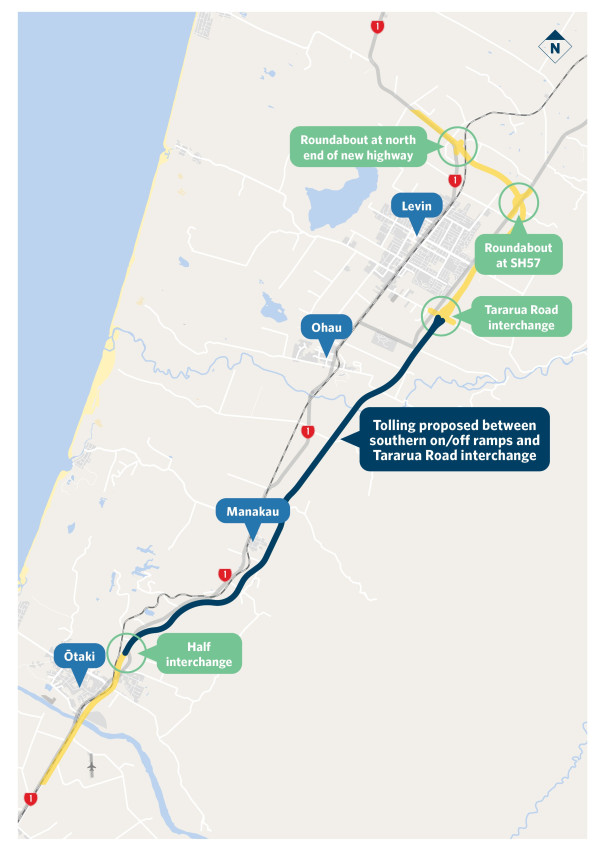In December 2024 the Government announced its decision confirming the tolling proposal for the Ōtaki to north of Levin new highway (Ō2NL).
The Minister of Transport’s full announcement can be viewed here:
Beehive.govt.nz(external link)
The Government Policy Statement on land transport 2024 (GPS 2024) sets a clear expectation for NZTA to consider tolling to support the construction and maintenance of all new roads, including the Roads of National Significance. This new road met the criteria for tolling and the technical information showed a strong financial case for it to proceed as a tolled road.
While the toll cannot be used to directly fund other regional projects, it will free up money in the National Land Transport Fund (NLTF) to invest in important transport infrastructure projects nationwide, including projects in the region.
Tolling revenue will fund maintenance and operations of the new Ō2NL highway. This will ensure the road continues to be safe and resilient without additional pressure on the NLTF.
While construction of the new Ō2NL highway is Crown funded, tolling revenue could also provide the ability to top up funding if costs were to change.
|
Section |
Light vehicles |
Heavy vehicles (Over 3500kg gross vehicle mass) |
|
Southern half interchange to Tararua Road interchange |
$2.70 |
$5.40 |
|
Tararua Road interchange to northern end of Ō2NL |
No toll |
No toll |
The toll prices are in 2024 dollars. The opening of the new Ō2NL highway is still several years away, and factors including Consumer Price Index increases between now and road opening could affect the actual price at the time of the road opening.

Location of the proposed toll road.
The 24km new Ō2NL highway will improve reliability, safety and efficiency for those moving around or through the Horowhenua District and lower North Island and will increase transport choices for the area’s growing population.
The new highway is expected to reduce travel times. Without the new highway, evening peak trips in 2039 on the current highway from Ōtaki to north of Levin are expected to take 32-33 minutes, compared to 17-21 minutes for trips on the new highway. In 2039, trips from Ōtaki to Levin town on the current highway are expected to take 23 minutes if Ō2NL isn’t built, compared to 17 minutes on the new highway.
The more reliable and resilient new highway will enable travellers to better plan their travel and become more efficient. This is particularly important for freight and logistics companies on the critical Wellington to Palmerston North link. The new Ō2NL highway is being designed to modern safety standards and will have a KiwiRAP (Road Assessment Programme) rating of 4 or more on the 5-star safety rating.
Every time a new state highway is built in Aotearoa New Zealand, NZTA carries out an assessment to see if it meets the criteria to be tolled.
Tolling provides an opportunity for an additional source of revenue, protecting the existing funding in the NLTF, and will support faster delivery of infrastructure, providing safer and more efficient routes.
The Land Transport Management Act 2003 allows a toll to be established, as a mechanism for funding road infrastructure projects and sets out the process required.
The Land Transport Management Act 2003(external link)
Tolling assessments are designed to analyse tolling feasibility, including how a potential toll road might interact with the wider transport network
Tolling proposals are assessed against a number of criteria before progressing to public consultation:
All toll roads in New Zealand are required to have a feasible, untolled, alternative route available to road users. In the case of Ō2NL, the current SH1/SH57 provide an untolled alternative.
Implementing a toll on the new highway could result in some drivers who may have travelled on Ō2NL choosing instead to stay on existing roads. Modelling shows when the road opens a tolled Ō2NL could result in approximately half of the traffic expected on the southern section of the new highway instead continuing to use the existing roads or choosing other options. The existing SH1 would still see a considerable drop in vehicle numbers once the new highway opens. South of Ōhau in 2029, traffic would reduce by 38% compared to if Ō2NL was not built.
In terms of traffic volumes, without the new highway modelling shows the existing SH1 south of Ōhau would be expected to have 23,100 vehicles per day in 2029. This would drop to 14,300 per day with a tolled Ō2NL highway. Without tolling on the new highway, vehicle numbers would be expected to drop to 5,400 per day at the same location.
If the southern section of Ō2NL was tolled, this would also affect the amount of traffic that continues to use the existing SH1 through Levin town centre. The existing SH1 through the town centre would still see a drop in vehicle numbers once the new highway opens. Modelling shows that in 2029, traffic would reduce by 17% compared to if Ō2NL was not built.
The existing SH1 through Levin town centre would be expected to have 14,100 vehicles per day in 2029, without the new highway. This would drop to 11,700 per day with a tolled Ō2NL highway. Without tolling on the new highway, vehicle numbers would be expected to drop to 8,400 per day at the same location.
Long term, other tolling sites around the country have seen more traffic move from local routes to the tolled routes over time as the benefits of the new road become clear.
NZTA thanks everyone who made submissions during the consultation process. Public consultation is a valued part of the process and the insights gained through submissions were considered in the decision-making process.
A summary of the consultation findings for Ō2NL can be viewed here:
SH1 Ōtaki to north of Levin tolling proposal consultation report [PDF, 2.1 MB]
The Ō2NL tolling consultation brochure can be viewed here: